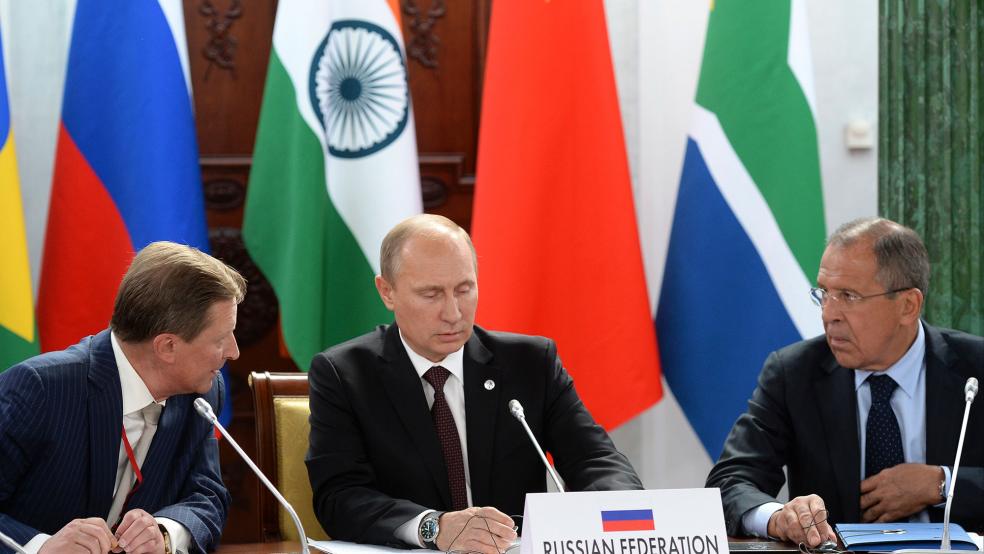A riddle, wrapped in a mystery, inside an enigma. That’s how former British Prime Minister Winston Churchill famously described the behavior of Russia and its politicians. The problem for investors is that figuring whether — and how — to invest in the country never seems to get any easier than deciphering the behavior of leaders like Joseph Stalin or Vladimir Putin.
That isn’t going to stop some from dabbling for bargains in blue-chip energy companies like Gazprom, Lukoil or Norilsk Nickel, betting simultaneously on a global commodities market recovery and that Russia won’t spend too much time in the shadow of the world’s disapproval.
Related: Big Risks Seen in Putin’s Idea to Beef Up Gazprom
There was some logic behind that argument back in mid-March, when the iShares MSCI Russia Capped Index ETF (one measure of the market’s performance) was trading down 28 percent year-to-date. Indeed, at that point the Russian occupation of the Crimean peninsula — until then, Ukrainian territory — and the growing tensions between the two nations had caused a selloff that left blue-chip Russian shares trading nearly 60 percent below their 2008 highs. “When an asset has fallen that far, it’s usually oversold,” asserted Brett Arends at Quartz, explaining his decision to jump back into the Russian stock market with both feet back at the beginning of March. “The market has given up and lost interest.”
There’s another possibility of course: Investors were just terrified of what might happen next. Geopolitically, things have deteriorated steadily since then. True, the Ukrainian elections did take place, but that’s no guarantee that tensions in the eastern portion of Ukraine will abate. Ahead of those elections, with chocolate magnate and pragmatist Petro Poroshenko widely seen as likely to win the presidency, Russian stocks rallied. Poroshenko has personal business ties to Russia; the Russian political establishment has made it clear that they’re just fine with him in driver’s seat next door in Ukraine.
Related: Ukraine’s New Leader Stands Up to Moscow
That cleared the way for a big rebound in Russian stocks from their lows. In the last month, the Market Vectors Russia ETF has rallied about 12 percent. That still means it’s down more than 8 percent so far this year, but it’s a far cry from the 27 percent loss investors were eyeing as of mid-March. As always, however, it has been a matter of buying the rumor and selling the news: Russian stocks have been falling once more now that investors are free to look around and worry about something else.
And if you’re looking for a reason to be jittery, you’ve got plenty to pick from.
While the crisis has cooled off, economic sanctions imposed by the United States and the European Union remain. On balance, that’s going to make risk-averse institutional investors more likely to lighten their holdings of Russian stocks and bonds and look for other places to park their cash, however appealing the bargains in the Russian markets look. Even the SEC has suggested that this might not be the best time to be investing in Russia. Not a very good sign.
Herman Gref, CEO of Sberbank, which holds about half of all Russian deposits, warned an economic forum recently that the country’s economy could stagnate and that the Ukraine crisis is taking a bigger toll than he had anticipated. The International Monetary Fund, for its part, has said Russia may already be in a recession, as everything from consumer confidence to capital investment takes a nosedive.
The landmark 30-year deal to supply China with massive quantities of natural gas couldn’t have come at a better time for Russia. It signals that the country doesn’t have to rely only on European markets for its oil and gas reserves. More broadly, the deal also is a reminder that Russian companies can generate profits by developing fresh markets with new trading partners.
Related: Obama’s Energy Plan Is a Gift to Russia and China
As with so many other developments involving Russia, what is obvious is how potentially transformative, both economically and politically, this $400 billion gas sale will be for both countries.
Where it once again becomes tricky is how an investor can position himself to make a profit from it. Invest in Gazprom, the company that will be developing this brand new market, diversifying its customer base and profiting from a big new sale? Not so fast. Gazprom’s domestic markets are stagnant, it faces big unpaid bill for gas from Ukraine, and then there are those sanctions looming on the horizon.
On top of that, the company – or the Russian government – will need to figure out how to pay its share of the sky-high development costs to build the new China pipeline. No wonder Bank of America Merrill Lynch cut their rating on Gazprom’s stock to a hold from buy.
Sometimes, bargain-priced merchandise is cheap for a very good reason.
Top Reads from The Fiscal Times:
- Americans Are Still Idiots When It Comes to Investing
- Economy May Never Fully Recover from Crisis
- Congress Is Blowing Our Best Chance to Rebuild America






